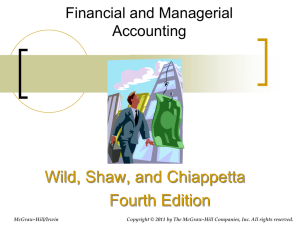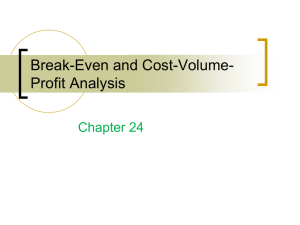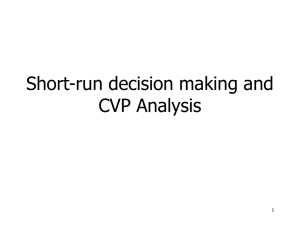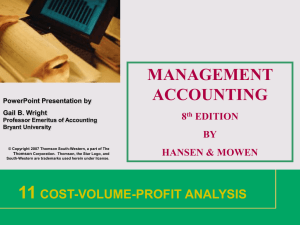Variable Costs
advertisement
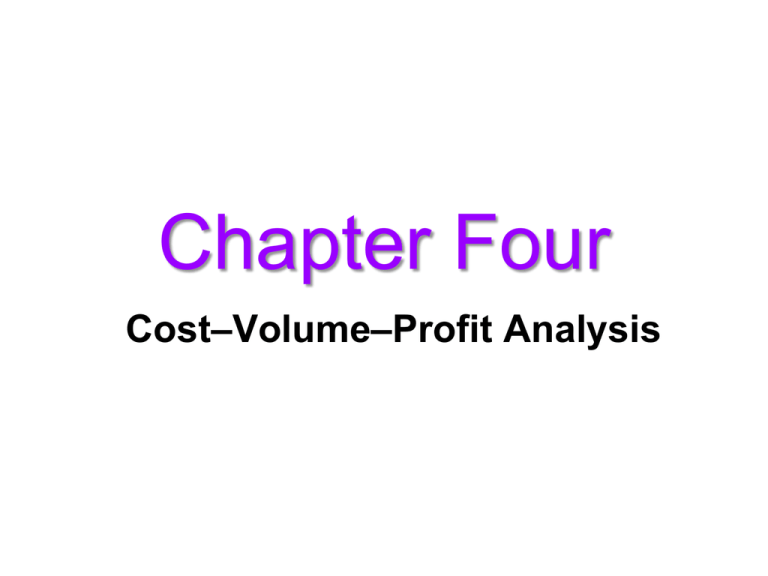
Chapter Four Cost–Volume–Profit Analysis CVP Analysis • Estimates how changes in costs, sales, volume, and price affect a company’s profit. • Powerful tool for planning and decision making. • Most versatile and widely applicable tools used by managerial accountants to help managers make better decisions Break-Even Point • Point where Total Revenue = Total Costs • Use contribution margin income statement to calculate the Break-even point. • Break-even point can be calculated in number of units and sales dollars. • Once fixed costs have been covered, net income will increase by the per unit contribution margin for each additional unit sold Contribution Margin • CM = Revenue – Variable Costs • CM represents the amount available to cover fixed expenses and thereafter provides profits. • CM can be calculated in total or per unit. • CMU = Selling Price – Var. Cost per Unit Contribution Margin Income Statement Sales Revenue (Variable Costs) Contribution Margin (Fixed Costs) Operating Income *When using this format, costs include product as well as period costs. • Whittier Company plans to sell 1,000 mowers at $400 each in the coming year. Product costs include: – Direct materials per mower – Direct labor per mower – Variable factory OH per mower – Total fixed factory OH $180 $100 $25 $15,000 – Variable selling expense is a commission of $20 per mower; fixed selling and admin expenses totals $30,000 Contribution Margin Income Statement Sales ($400 * 1,000) Variable cost ($325 * 1,000) Contribution margin Fixed costs Operating income $400,000 (325,000) $ 75,000 ( 45,000) $ 30,000 *CM per unit = $400 – 325 = $75 **VC per unit = $180 + 100 + 25 + 20 ***FC = $15,000 + $30,000 = $45,000 Break-even Point in Units Sales – VC - FC = Operating Income • At break-even point, operating income = $0. • Calculate BE point in units using previous example: Sales – VC – FC = Income $400X - $325X - $45,000 = $0 $400X - $325X = $45,000 $45,000 / $75X X = 600 mowers Break-even Point in Units • Operating income equation can be rearranged as follows to calculate number of units at breakeven • BE units = Total FC / (SP – VC per unit) • Looking back at previous example • =$45,000 / ($400 - $325) Break-even Point in Sales Dollars • Unit sold measure is converted into sales dollars # of units sold * sales price per unit = sales revenue • Sales revenue needed in order to breakeven =600 mowers * $400 = $240,000 Variable Cost Ratio & Contribution Margin Ratio • VC Ratio = VC expressed as % of sales dollars • CM Ratio = CM expressed as % of sales dollars • VC Ratio + CM Ratio = 100% • If VC Ratio = 70%, then CM Ratio = ? % Variable Cost Ratio • Variable Cost Ratio – proportion of each sales dollar that must be used to cover variable costs • Can be calculated using total data or unit data VC Ratio = VC per unit / SP per unit • VC Ratio = $325 / $400 • VC Ratio = 81.25% Contribution Margin Ratio • Percentage of sales dollars remaining after variable costs are covered • Proportion of each sales dollar available to cover fixed costs and provide for profit CM Ratio = CM per unit / SP per unit • CM Ratio = $75 / $400 • CM Ratio = 18.75% Break-even Point in Sales Dollars BE Sales = FC / CM Ratio • BE Sales = $45,000 / 18.75% • BE Sales = $240,000 Calculating Sales Needed to Earn a Target Operating Income • Whittier sells mowers at $400 each. Variable cost per unit is $325 and total fixed cost is $45,000. • Calculate sales that Whittier must make to earn an operating income of $37,500 Sales – VC – FC = Operating Income $400X - $325X - $45,000 = $37,500 $75X = $82,500 X = $82,500 / $75 X = 1,100 What happens if a company sells more than one product? Whittier Company • Decides to offer two models of lawn mowers: mulching mower (SP = $400) & riding lawn mower (SP = $800) Mulching Mower (1,200 units, 60%) Riding Mower (800 units, 40%) Total (2,000 units) Sales $480,000 $640,000 $1,120,000 Less: Variable Expenses ( 390,000) ( 480,000) ( Contribution Margin $ 90,000 $160,000 $ 250,000 Less: Fixed expenses ( ( ( 70,000) Product Margin $ 60,000 $ 180,000 Less: Common fixed expenses Operating Income 30,000) 40,000) $ 120,000 870,000) ( $ 26,250) 153,750 Weighted-Average Contribution Margin per Unit • In the real world, a company sells more than one product. • Have to find weight-average contribution margin: • Several ways to calculate, but one way is-total contribution margin divided by the total units: $250,000/2,000 = $125 • Use $125 to find break-even point for company. – $125X – 70,000 – 26,250 = $0 – $125X = $96,250 – X = $96,250/$125 – X = 770 units • How many mulching mowers? – 770 * 60% = 462 • How many riding mowers? – 770 * 40% = 308 Margin of Safety • The units sold or revenue earned above the break-even volume. • “Wiggle room” = Actual or Target Sales – Breakeven Sales Example Whittier Company • Break-even Point = 600 units or $240,000 sales dollars • Target Point = 1,000 units or $400,000 sales dollars Margin of Safety: • Units = 1,000 – 600 = 400 units • Sales dollars = $400,000 – 240,000 = $160,000 Operating Leverage • Concerned with the relative mix of fixed costs and variable costs in an organization. • As variable costs decrease, the unit CM increases, making the contribution of each unit sold that much greater. • Degree of OL = CM / Operating Income Operating Leverage • Whittier plans to sell 1,000 mowers at $400 each and has VC per unit of $325 and FC of $45,000. Operating income at that level of sales is $30,000. – OL = $75,000 / $30,000 = 2.5 • Use of OL: Degree of OL * % change in sales = % change in income • If company sales increase 20%, but how much income increase? – 2.5 * 20% = 50%




